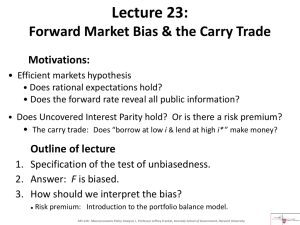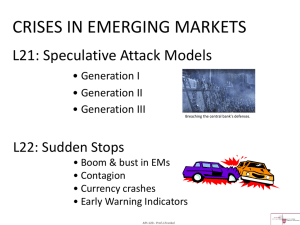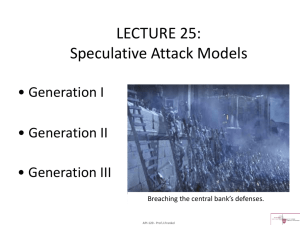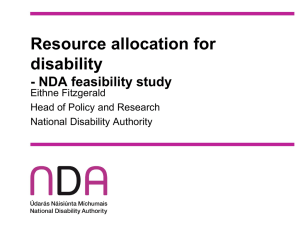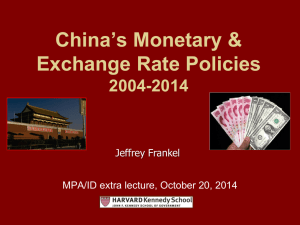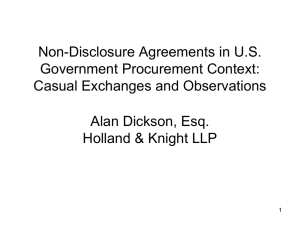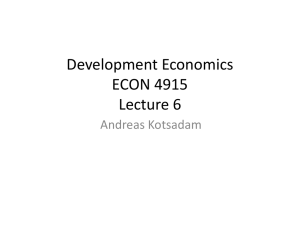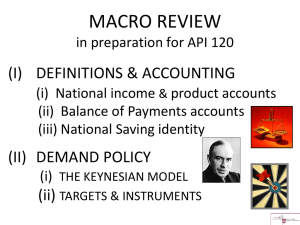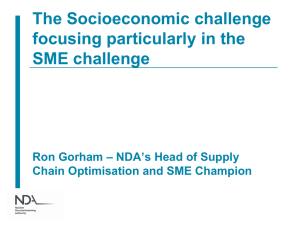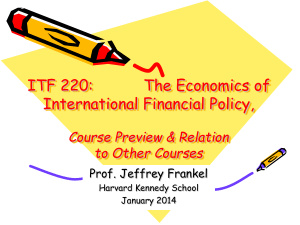Speculative attack models
advertisement
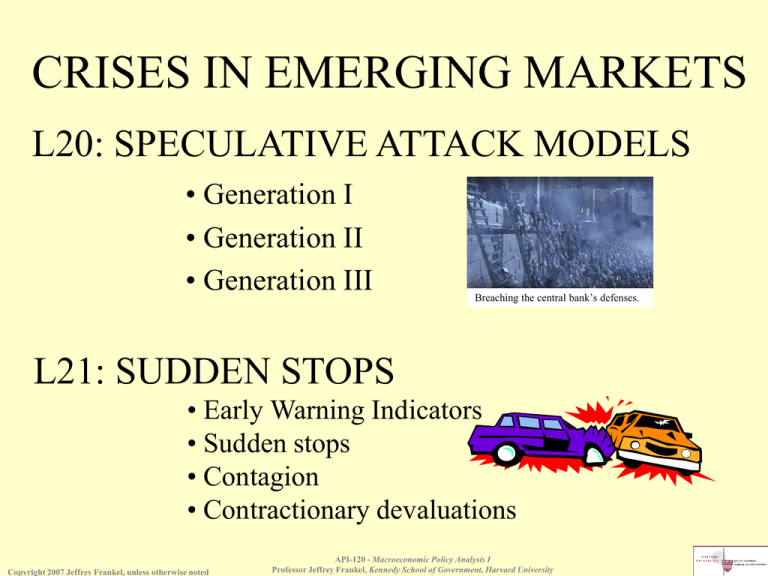
CRISES IN EMERGING MARKETS L20: SPECULATIVE ATTACK MODELS • Generation I • Generation II • Generation III Breaching the central bank’s defenses. L21: SUDDEN STOPS • Early Warning Indicators • Sudden stops • Contagion • Contractionary devaluations Copyright 2007 Jeffrey Frankel, unless otherwise noted API-120 - Macroeconomic Policy Analysis I Professor Jeffrey Frankel, Kennedy School of Government, Harvard University LECTURE 20: SPECULATIVE ATTACKS Breaching the central bank’s defenses. Traditional pattern: Reserves gradually run down to zero, at which point CB is forced to devalue. Copyright 2007 Jeffrey Frankel, unless otherwise noted API-120 - Macroeconomic Policy Analysis I Professor Jeffrey Frankel, Kennedy School of Government, Harvard University In 1990s episodes, reserves seem to fall off a cliff See graphs for Mexico, 1994…. An “irrational” stampede? Not necessarily. Rational expectations theory says S can’t jump unless there is news; this turns out to imply that Res must jump instead. Copyright 2007 Jeffrey Frankel, unless otherwise noted API-120 - Macroeconomic Policy Analysis I Professor Jeffrey Frankel, Kennedy School of Government, Harvard University API-120 - Macroeconomic Policy Analysis I Prof.Jeffrey Frankel, Kennedy School of Government, Harvard University Models of Speculative Attacks First Generation Episodes that inspired model Bretton Woods crises 1969-73; 1980s debt crisis Copyright 2007 Jeffrey Frankel, unless otherwise noted "Whose fault is it?" and why Seminal authors Macro policies: Krugman (1979); excessive credit Flood & Garber (1984) expansion API-120 - Macroeconomic Policy Analysis I Professor Jeffrey Frankel, Kennedy School of Government, Harvard University Models of Speculative Attacks, continued Second Generation "Whose fault is it?" Episode inspiring model ERM crises 1992-93: Sweden, France International financial markets: multiple equilibria Copyright 2007 Jeffrey Frankel, unless otherwise noted Seminal authors 1. Speculators’ game Obstfeld (1994); 2. Endogenous monetary policy Obstfeld (1996), Jeanne (1997) 3. Bank runs Diamond-Dybvyg (1983), Chang-Velasco (2000) 4. With uncertainty Morris & Shin (1998) API-120 - Macroeconomic Policy Analysis I Professor Jeffrey Frankel, Kennedy School of Government, Harvard University Models of Speculative Attacks, concluded Third Generation Episode inspiring model "Whose fault is it?" Structural Emerging fundamentals: market crises moral hazard of 1997-2001 (crony capitalism) Copyright 2007 Jeffrey Frankel, unless otherwise noted Seminal authors Dooley (2000) insurance model; Diaz-Alejandro (1985); McKinnon & Pill (1996); Krugman (1998); Corsetti, Pesenti & Roubini (1999); Burnside, Eichenbaum & Rebelo (2001) API-120 - Macroeconomic Policy Analysis I Professor Jeffrey Frankel, Kennedy School of Government, Harvard University 1st-generation model of speculative attack: Krugman-Flood-Garber version uses the flexible-price monetary model of exchange rate determination. Start with Cagan money demand function: m p y i i i * s Add uncovered interest parity: e } } m p y (i * s ) e Assume flexible prices, implying PPP: s p p * and output at potential => m s y s (We will assume no money growth or inflation abroad and have normalized m*-y* =0. Only domestic money growth matters.) Copyright 2007 Jeffrey Frankel, unless otherwise noted API-120 - Macroeconomic Policy Analysis I Professor Jeffrey Frankel, Kennedy School of Government, Harvard University e Consider a transition in regimes from fixed to floating rates. Under fixed rates, move s to the RHS to get an equation of determination of the money supply: m s y s (Recall M≡NDA+R, where R ≡ forex reserves expressed in terms of domestic currency.) Or under floating, move m to the RHS to get an equation ~ of exchange rate determination: s m y s . e e Krugman experiment: Central bank undertakes a fixed rate of growth of domestic credit d ( NDA ) dt / NDA d ( nda ) dt As long as s is fixed, at s , nda t nda => dR dt d ( NDA ) dt API-120 - Macroeconomic Policy Analysis I, Prof. J.Frankel, Harvard Kennedy School 0 t . Flood-Garber shadow floating exchange rate: ~ Define shadow price s t nda t y nda 0 t y (After all reserves are lost, m will consist only of nda.) When does the speculative attack occur, defined as t=T ? Rational expectations precludes jumps. Therefore it happens when ~ st s nda 0 T y T => s nda 0 y While rate is still fixed: s m y * 0 m y log( NDA R ) y => T log( NDA 0 R 0 ) nda 0 Lessons: If initial R0 is high, T is far off. If is high, T is soon. Krugman-Flood-Garber Model of Speculative Attack Made Easy (JF ) NDA S 7 5 1 2 S 10 t t T MB R 6 3 } 8 } 9 T Copyright 2007 Jeffrey Frankel, unless otherwise noted t T API-120 - Macroeconomic Policy Analysis I Professor Jeffrey Frankel, Kennedy School of Government, Harvard University 4 t 1. Assume the exchange rate is pegged at S . 2. Assume NDA grows exogenously at rate , to finance BD 3. Reserves, R, flow out through the balance of payments, so MB does not grow beyond the level of money demand (in accordance with the MABP). With complete offset, every $1 of NDA creation causes $1 of reserve loss . 4. We want to find T, date of speculative attack. Will speculators wait until R hits 0? No: By then there would not be enough foreign reserves to go around. 5. If speculators waited until R ran down to 0, the disequilibrium between demand & supply of money would require a discontinuous jump in S -- predictable ahead of time, a violation of rational expectations. => The attack must come sooner. 6. Does the attack come as soon as the trend of expansion in domestic credit (NDA) is set? No: Before T arrives, there is no reason for money demand to fall, because inflation and depreciation have not yet risen. and so M demand does not change during initial period. (Remember, this model assumes flexible prices, PPP, and Y = Y .) Copyright 2007 Jeffrey Frankel, unless otherwise noted 7. Assume new regime will be a pure float. => S & P will also increase at rate in the post-attack regime. 8. When T arrives, people switch discretely out of domestic money into foreign. The magnitude of the shift is , where is the semi-elasticity of money demand with respect to the rate of inflation. 9.This can only happen if at time T, ∆ R = -. On one day, speculators acquire the central bank’s entire remaining stock of R. T is determined by the date when R has fallen to . This is the central result. 10. The attack occurs when Flood-Garber “shadow floating rate” ~s t -- the S that would occur at any time t if the currency were to float, determined by the level of NDA at t -- crosses the peg level s . Only in this way is a jump in S precluded at the time of the transition from one regime to another -- the no-jump condition required by rational expectations. Copyright 2007 Jeffrey Frankel, unless otherwise noted API-120 - Macroeconomic Policy Analysis I Professor Jeffrey Frankel, Kennedy School of Government, Harvard University Krugman-Flood-Garber Model of Speculative Attack Made Easy (JF ) NDA S 7 5 1 2 S 10 t t T MB R 6 3 }8 } 9 T Copyright 2007 Jeffrey Frankel, unless otherwise noted t API-120 - Macroeconomic Policy Analysis I Professor Jeffrey Frankel, Kennedy School of Government, Harvard University T 4 t 2nd-generation model of speculative attack: Obstfeld version (a) Strong fundamentals (b) Weak fundamentals (c) Intermediate fundamentals Obstfeld (1986). Assume: * If the central bank’s reserves are exhausted, it has to devalue, by 50%. * Each trader’s holdings of domestic currency = 6. * Transaction cost = 1 (e.g., foregone interest when holding forex). (a) If fundamentals are strong (high R), neither speculator sells the currency <= Each realizes if he were to sell, the central bank could withstand the attack. => Equilibrium: no attack. (b) If fundamentals are weak (low R), speculators sell the currency. Each realizes that even if he does not sell, the other will; the central bank exhausts its reserves & is forced to devalue, earning profit for seller (50%*6-1) = 2 if one sells; (50%*(6/2) -1) = ½ if both sell. There are not enough reserves to go around. => Equilibrium: successful speculative attack. (c) If fundamentals are in between (R is intermediate), outcome is indeterminate. Each speculator will attack iff he thinks the other will attack. If either sells alone, the central bank can defend, and the seller loses. But if both sell, the central bank exhausts its reserves and devalues, leaving a profit for each (50%*(10/2)-1 = 1 ½). => There are two Nash equilibria: either nobody attacks or both do. 3rd-generation model of speculative attack: Dooley’s insurance model The crisis occurs at T, when stock of liabilities that have a claim on being bailed out equals pot of Reserves to bail them out with. Copyright 2007 Jeffrey Frankel, unless otherwise noted API-120 - Macroeconomic Policy Analysis I Professor Jeffrey Frankel, Kennedy School of Government, Harvard University
